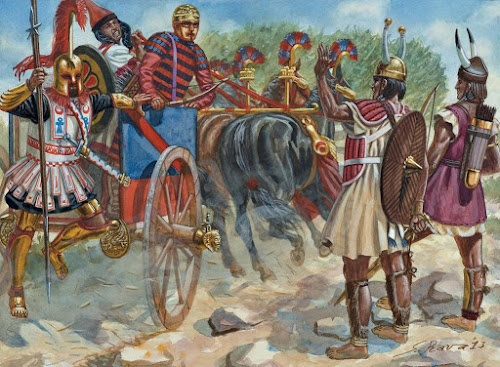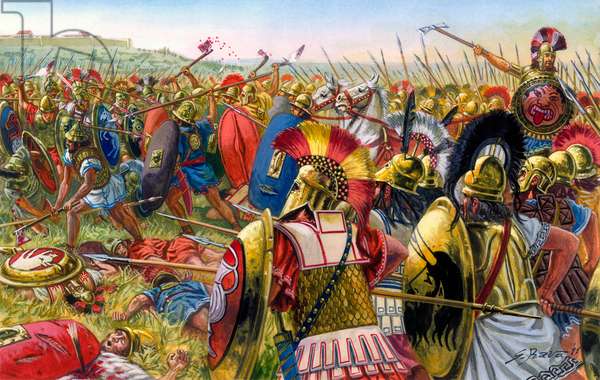Sasanid Persians at Derventio V
The last weekend in October saw the MeG regulars, plus some less than regulars, gather at Boards and Swords Hobbies in Derby for the 5th running of Will Denham's Derventio competition. I took an all time favourite of mine, Middle Sasanid Persians. Read on to see how they did ...
Whilst I have used Middle Sasanids more than a few times, and with some success, I haven't run them at a competition for a while. As Derventio is a "Classical" period competition this seemed an excellent time to bring them out again.
I came up with a new list and one that, for once, didn't include elephants.
This version is probably the most "fighty" Sasanid list I have run. With the 2 units of catafracts, 3 of Armenians, and only 4 of horse archers (other than skirmishers) it is a lot more direct than I am used to. It wins and loses on how well the catafracts and Armenians do (obviously), with the Superior catafracts probably being the key unit as you would expect.
So how did it do? Well, here are short reports on my 4 games.
First up was Kev Brewin with a Spartan army with Athenian and Theban allies. Lots of hoplites, many the especially effective Spartans is not a good match-up for a wholly mounted army.
I defended and in the PBS phase managed to get a mostly open battlefield which suited me perfectly. There was a deep water secure flank which helped Kev, but you can't have everything; and as the only other terrain was a gentle hill I was happy. I also outscouted the Greeks by a significant margin (can't recall exactly what) and so would see where he was first.
The table looked like this after we had both set up.
The Greek army wasn't as hoplite heavy as I thought it would be, however, most of them were Superior (and Melee Expert for the Spartans) which I couldn't really take on frontally. As you can see they deployed with deep water covering their right and extending out into the plain. Their left flank was held by a couple of small (4 base) cavalry units. I, inevitably, deployed well away from the river with only 2 small units of the armoured horse archers on my left whose role was to slow down the inevitable hoplite advance by just being there. My whole battle plan was to push heavily on my right to try and get round the flank and rear of the Greeks.
Kev sent some of his cavalry forward on his left to try and slow down my attempt to get round his flank in order to allow him as much time as possible to get his good infantry across the table at me. At the same time my small units of horse archers were slowing down his right. His cavalry did slow me up a bit but got shot up fairly quickly as I led the way on my right with other horse archers whilst my catafracts moved as fast as they could round behind them. Most of the Armenians also moved to my right although I did have to leave one unit behind to be a bit of a block on the oncoming Spartans.
Things proceeded in this vein for a couple of moves and after the demise of one unit of cavalry Kev brought up his (Superior) Theban hoplites to block me. Against these I lined up a reasonably amount of firepower.
The Thebans proved satisfyingly (if surprisingly) vulnerable to shooting and were forced to charge me and I got the necessary additional wounds on them and broke them. I also got my Superior catafracts round the back of the Greeks and a unit of my asvaran lined up to charge a Poor quality cavalry unit that Kev had had to bring up to delay me. I had, however, lost a unit of Armenians who couldn't get out of the way of some Spartans and who died rapidly.
My catafracts destroyed the cavalry they faced in short order, however, my asvaran failed to do the same to the Poor cavalry despite catching them in the rear when they ran away.
The game timed out shortly after this and we ended up with an 8-6 score line. First time Kev and I have played each other at MeG and very enjoyable.
Game 2 drew me against Graham Klaka with his Early Imperial Romans with his infamous Parthian ally - infamous as he has downgraded the catafracts to Poor which has raised some eyebrows. The PBS went my way and again the battlefield was a nearly empty plain and I outscouted the Romans (50% as I recall). We set up like this.
I have weighted my army to the left as I thought Graham's deployment was a little more vulnerable on this flank. Although the end of the line is held by Exceptional legionaries, it is hanging in the air a bit and the next unit in line are auxiliaries rather than tougher legionaries. His left has competent cavalry and another unit of Exceptional troops so in my view harder to get round and so I look to hold these up with various horse archers. I have my catafracts in the centre held back a bit to intervene where I need them.
The next 2 pictures show how the first few moves panned out.
On my far left I have effectively pinned one of the Exceptional units out of the battle with a unit of my asvaran who are sitting directly in front of them. When charged they will chose to Run Away which means that they cannot be caught by the infantry, although their chances of inflicting shooting damage is significantly removed. However, I feel that this allows me to concentrate my Armenians on softer targets. I have the auxilia and a unit of the Poor catafracts lined up for them. On my right I have a horse archer reception committee for the Roman cavalry and a unit of catafracts around to keep the second Exceptional infantry unit honest. My Superior catafracts are teed up to charge a legionary unit - a close fight but my catafracts are better in prolonged melee.
Next move charges go in and fighting starts.
For a few moves after this I found the game got really frustrating in terms of things resolving - all thanks to dice rolls, of course. Whilst I wasn't being diced to death I felt that where I had manoeuvred to get advantages the dice rolls meant that they didn't happen as I felt they should have done. Of course, that is one reason we have dice in these games so that there is a nice level of unpredictability; but some times ...
So even a couple of moves later things looked pretty similar. I had even managed a flank charge on the Exceptional legionaries on my left with a unit of my Armenians, and pretty much failed to cause any damage. I did eventually break them but it took much longer than it should really. In the centre the combats dragged on with fairly even casualties despite my advantages.
On the plus side I shot away the Roman cavalry and lined up a flank charge on the other Exceptional unit.
Of course, this also failed to do any material damage ...
However, on my left things finally came good. With a charge in their rear the Exceptional unit on that flank broke and I got my Armenians into the flank of the auxilia and with help from some asvaran broke them. The pursuit took them into the rear of a legionary unit. In the centre I finally broke the units I was fighting and despite my failure on the right against the second Exceptional unit the Roman army broke.
15-5 to me. Despite the dice frustrations it was another great game that I really enjoyed - you just have to live with the dice and keep plugging away.
The Sunday morning game put me up against Roger Whittam and his Lowland Gauls. A big warband army with some useful mounted support in the shape of chariots and cavalry. His army included 2 allies, Spanish and Gaestati.
My PBS run continued and again the table was mostly an open plain with one smallish wood on Roger's base line. I also outscouted him by 80% and so would see nearly all of his army. Deployment ended like this.
Roger didn't have many options really. The Spanish held the wood, warband extended from that and he massed his chariots and cavalry on his left to swing out and try and combat my inevitable attack.
My deployment was not subtle. Catafracts on the right supported by a few horse archers, then all the Armenians, and the rest of the asvaran on the left. My plan was to use the catafracts to clear away his mounted and the Armenians to charge the warbands - the latter would probably break off after the first charge and go back in to maximise their charge phase advantages and hopefully capitalise on Shatters.
The second Armenian charge goes in and the Gallic line collapsed and the army broke.
15-0 to me. The terrain (or rather lack of it) was harsh on Roger and then my Superior catafracts basically broke 3 of his units for the loss of 2 bases. Of course, I was quite happy with this.
Last game saw me playing David Gollop. We have not played before and David is still fairly new to MeG, but a very experienced gamer with a lot of FoW success. He was using Classical Indian.
For the 4th game the PBS was very favourable for me and I again dictated an open field, plus I outscouted David by 100% so would see all of his army before deploying mine. The only terrain was a small field in the middle. I think here David's inexperience showed as could have attempted to have more say in the terrain than he ended up having - pretty sure he will do things differently in future.
David deployed as best he could (I wouldn't have done any better for sure), knowing full well that I would pick my point to attack. As it happened i chose to attack his left, but it would have been just as good to attack the right. It looked like this. Catafracts and asvaran on the left, Armenians in the centre, and the small asvaran units on the right to hold up David's left.
The game then finished quite quickly. The Superior catafracts broke the infantry they were fighting, pursued into another infantry unit and broke that in short order. The multiple routs and the asvaran fighting them also broke the other infantry unit that was in combat. With the elephant unit on that flank finally being shot away, the Indian army broke.
All in all a great weekends gaming.
Finally, for those who are interested in allied contingent stats in respect of going Hesitant, my 4 games had 9 allied contingents in them and here are their initial discs. All were Competent generals and none were hesitant. Somebody may wish to do the odds on that.






































Comments
Post a Comment